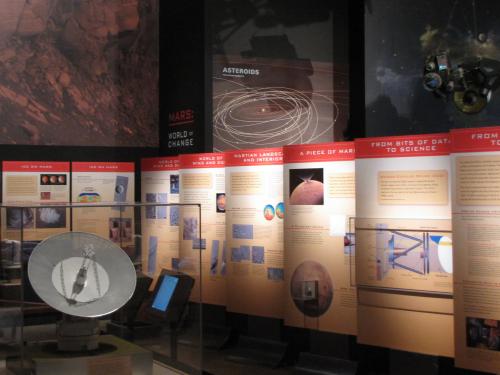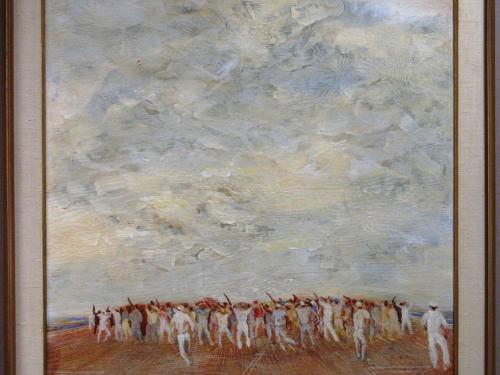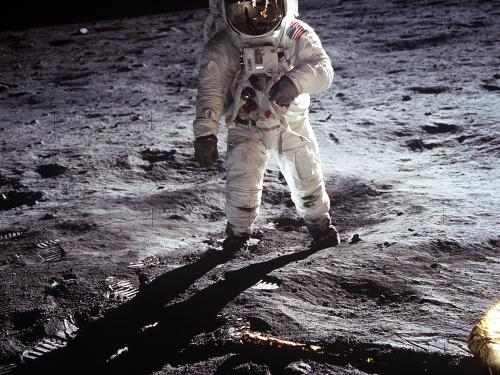

Stories of daring, stories of technological feats, stories of prevailing against the odds ... these are the stories we tell at the National Air and Space Museum. Dive in to the stories below to discover, learn, and be inspired.
Showing 1681 - 1690 of 1759

May 06, 2010
The superlatives tend to pile up pretty quickly when it comes to the rigid airship Hindenburg, the pride of the Deutsche Zeppelin-Reederei line...It’s a shame, though, that the Hindenburg is remembered today primarily for its tragic final flight.

May 03, 2010
When the National Air and Space Museum opened its doors in July 1976, it featured in its theater a film produced specifically for the Museum called To Fly in a large format called IMAX.

April 26, 2010
Sometimes seemingly ordinary people become extraordinary by staying remarkably calm and capable in a crisis. The crew of US Airways Flight 1549 performed exceptionally on January 15, 2009, when their Airbus A320 jetliner became disabled over New York City after flying through a flock of geese moments after they took off from LaGuardia Airport. Capt. Chesley B. “Sully” Sullenberger and First Officer Jeffrey B. Skiles masterfully guided the powerless aircraft to an emergency “landing” on the Hudson River.

April 22, 2010
On April 28th, we will be awarding the National Air and Space Museum’s Trophy Award for Current and Lifetime Achievement. The Trophy was initiated in 1985 and has been given every year but one since then. This year, the Lifetime Achievement Award will be given to Christopher C. Kraft, Jr., for a lifetime of service to aerospace, especially for his role in defining the responsibilities of Mission Control for human spaceflight at NASA. Anyone who has seen the Hollywood film Apollo 13 knows how crucial the mission controllers were in saving that mission and its crew from disaster. While the filmmakers may have exaggerated a few things, in that regard they were correct. Mission controllers—at first located at Cape Canaveral, later on in Houston—were critical to the success of all the human missions into space, and it was Kraft who determined their roles and responsibilities.

April 19, 2010
I teach an exhibition design course as an adjunct professor for the George Washington University’s Museum Studies program. I tell my students I’ve got the best job in the world: designing exhibitions for the Smithsonian’s National Air and Space Museum. They often ask what you need to know to be an exhibit designer and how they can get there, too.

April 15, 2010
The Exploring the Planets Gallery has been updated to include scientic exlporation of Mars. See what's new!

April 12, 2010
Every year as the anniversary of the first human spaceflight approaches, I receive calls inquiring about the validity of Yuri Gagarin’s claim as the first human in space. The legitimate questions focus on the fact that Gagarin did not land inside his spacecraft.

April 09, 2010
In addition to the “Apollo 11 Codices”, the National Air and Space Museum holds approximately 150 works by the artist Mitchell Jamieson (1915 – 1976). The “Apollo 11 Codices” exemplify Jamieson’s journalistic style of painting, which was one reason NASA brought him into its Fine Art Program. Aboard the U.S.S. Hornet, Jamieson sketched the seamen working to recover the capsule and crew from the successful Apollo 11 mission. Jamieson was known for his depictions of the onlookers at major events rather than the events themselves. This style allows the viewer to believe that they are there as part of the crowd, feeling the energy and excitement. Three of Jamieson’s works are traveling as part of the exhibition “NASA Art: Fifty Years of Exploration” organized by the Smithsonian Institution Traveling Exhibition Service (SITES) in cooperation with NASA and the National Air and Space Museum.

April 05, 2010
One of the things that makes being an educator here great is our teaching collection. I’m lucky, I work with a curatorial and collections staff that considers our needs as educators and provides the public with deaccessioned items they can touch and examine up close. Our teaching collection currently contains real space food, shuttle tiles, bits of airplanes, meteorites, uniforms and other assorted items. However, not all the items are real; our most popular replica is the shuttle era space suit. The suit has been part of the Discovery Station Program for over ten years. It was purchased with a grant from the Smithsonian Women’s Committee and is part of the Living and Working in Space Discovery Station, our most popular station, largely because of the suit. The station gets an average of 40,000 visitors yearly, but that’s only a portion of the crowds the suit sees. It has also become a key object used for family days, story times and school tours.

April 01, 2010
In the summer of 2009 the United States celebrated the fortieth anniversary of the first Moon landing, Apollo 11. Amidst all of the hoopla virtually every news story, especially in the electronic world, made some comment about a supposedly rising belief that humans have never landed on the Moon. Why?